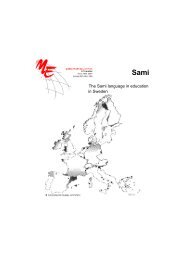Multilingual Early Language Transmission (MELT) - Mercator ...
Multilingual Early Language Transmission (MELT) - Mercator ...
Multilingual Early Language Transmission (MELT) - Mercator ...
You also want an ePaper? Increase the reach of your titles
YUMPU automatically turns print PDFs into web optimized ePapers that Google loves.
should adopt strategies to reinforce the minority language, so as to provide varied language<br />
input. The final factor of Grosjean’s (2010) figure are the “attitudes” that people have<br />
toward bilingualism and bilingual culture. Positive language attitudes of parents, teachers,<br />
and peers are very important for the development of a bi- or multilingual child.<br />
A child has to feel that he/she really needs a particular language. The need can be of various<br />
kinds: to communicate with family members, caretakers, friends, to participate in the<br />
activities of day care or school, to watch television, to do sports and so on. The combination<br />
and relation of the need for a language and the factors mentioned above stimulate language<br />
acquisition.<br />
3.5 Bilingual First <strong>Language</strong> Acquisition (BFLA)<br />
In this section special attention will be paid to the multilingual language acquisition process.<br />
In a bilingual situation afamily usually adopts an approach at which the child receives input<br />
in two languages (perhaps one language is spoken by the father and the other one by the<br />
mother, or one language by the parents and the other by a caretaker such as a nanny or at a<br />
day care centre) (Grosjean, 2010).<br />
BFLA (Bilingual First <strong>Language</strong> Acquisition) focuses on the simultaneous acquisition of two<br />
languages spoken at home from birth (De Houwer 2009). BFLA children learn to understand<br />
two first languages concurrently. In a quarter of the cases, BFLA children will also speak two<br />
languages from early on, and quite a few BFLA children speak just one language (De Houwer,<br />
2009). The central focus of BFLA studies is the compensation of discusses the development<br />
of a bilingual child and a monolingual child. Below an overview of the history BFLA is<br />
presented.<br />
De Houwer (2009) claims that the first extensive, book-long study of a child growing up with<br />
two languages from birth was published almost 100 years ago. The French linguist Ronjat<br />
(1913) gives a good, global description of an individual child’s bilingual development, based<br />
on the model one person, one language. He studied his son as an example, who heard Dutch<br />
and French from birth on. Ronjat followed the German psychologists Wilhelm and Clara<br />
Stern (1907, republished as Stern and Stern, 1965), who are describing language<br />
development against the backdrop of children’s overall development.<br />
The next large BFLA study is by the German-American phonetician and linguist Werner<br />
Leopold (1939, reprinted 1970). Much of his work was based on the linguistic development<br />
of Leopold's daughter Hildegard, and he described his findings in four volume studies. He is<br />
obviously convinced that learning two languages in early childhood had no negative<br />
consequences for the child’s development. Leopold also claimed that the best model for<br />
developing bilingualism in a child is the one person, one language strategy. He published one<br />
of the first exhaustive case studies on the simultaneous acquisition of two languages.<br />
Leopold also used the term ‘child languages’ for the first time (Hakuta, 1983).<br />
57



